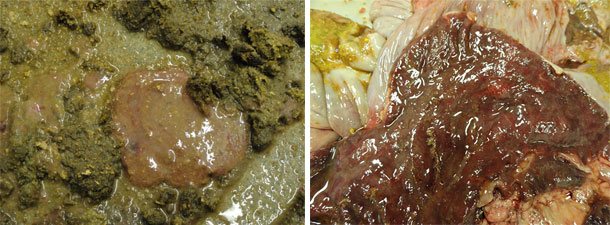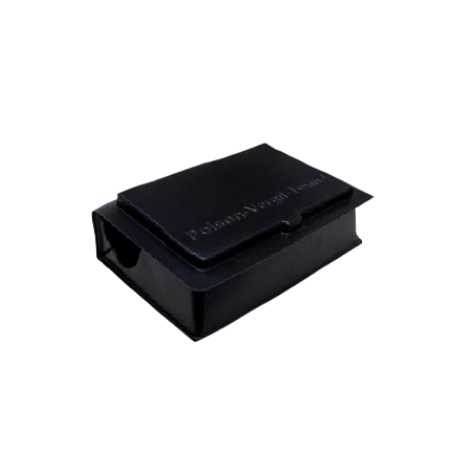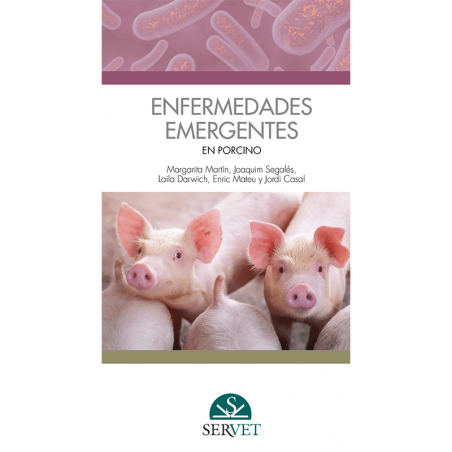Brachyspira spp. are Gram-negative, oxygen-tolerant, anaerobic spirochetes which inhabit the large intestines of many species including pigs, rodents, dogs, and birds. Infection with these bacteria results in varying levels of clinical disease ranging from an inapparent carrier state to severe bloody diarrhea, and this variance depends upon the species of animal infected and the particular species of Brachyspira involved. Co-infections with both highly virulent and avirulent Brachyspira spp. may also occur.
Two species of Brachyspira are well-recognized pathogens of pigs: Brachyspira pilosicoli, which causes porcine colonic spirochetosis (PCS), and Brachyspira hyodysenteriae, the agent of swine dysentery (SD). Piglets are typically infected horizontally on endemically infected farms and clinical disease is often first noted 10 – 14 days after pigs are moved from the nursery. On many farms, this period is associated with removal of antibiotics from the ration which may play a role in disease manifestation. Diarrhea may also occur subsequent to other forms of stress such as movement, mixing of pigs, and dietary changes.

PCS typically results in diarrhea with a glistening appearance and a consistency similar to wet cement. Upwards of 30% of pigs in a group may exhibit diarrhea and poor growth which may last for 4 – 6 weeks; however, mortalities are not common. Affected groups may take considerably longer to reach market weight and this reduction in growth rate accounts for the economic losses attributable to PCS.
SD was first described in the 1920s and is considerably more severe than PCS. Typical outbreaks of SD are associated with profuse bloody diarrhea, often with abundant mucus (figure 1). In some cases, feces may contain strands of fibrin and sloughed intestinal tissue. In acute outbreaks affecting weaner pigs, the morbidity is often very high and mortalities may approach 30%. Gross lesions are limited to the large intestine and include mucosal erosion, hemorrhage, and copious luminal mucus (figure 2). Diagnosis of SD is based upon appropriate clinical signs, gross lesions, histopathologic confirmation, and culture of a strongly beta-hemolytic spirochete from colonic tissues or feces of affected pigs.

| Figure 1: Diarrhea with blood and mucus from a pig infected with Brachyspira hyodysenteriae. | Figure 2: Spiral colon from a pig infected with Brachyspira hyodysenteriae revealing hemorrhage and abundant mucus along the mucosal surface. |
SD was thought to have been eliminated from the majority of US swine herds in the 1990s due to improved management conditions and control strategies; however, in recent years the frequency of diagnosis of this disease has been on the rise in the US and Canada. Additionally, dysentery-like disease has been reported, and experimentally reproduced, in pigs in association with infection by strongly beta-hemolytic spirochetes which are not identified as B. hyodysenteriae by currently available polymerase chain reaction (PCR) assays that are described as specific for this species. Whether these spirochetes represent truly novel species or simply the effects of mutation is not yet fully known. It is clear, however, that culture appears to be a more sensitive assay than PCR in detecting potentially pathogenic spirochetes in the feces of affected pigs and should be an integral part of the diagnostic approach for cases of bloody scours in weaner pigs.
The most significant source of infection with Brachyspira spp. for pigs is ingestion of fecal material from a clinically affected cohort; however, asymptomatic animals may shed the organism into the environment, and transmission has been reported from pigs without clinical evidence of disease for more than 60 days. Continuous flow systems and poor biosecurity may contribute to transmission. Brachyspira spp. are relatively resistant in the environment, particularly within moist fecal matter, and transmission can occur by contaminated footwear and other fomites. B. hyodysenteriae survives well in lagoon water and disease has been reproduced in susceptible pigs by exposure to contaminated lagoon effluent. Other animals on the farm may also transmit the organism including dogs, mice, rats, and birds. Viable pathogenic spirochetes have been recovered from the feces and feet of wild rodents and birds and suggest these sources may be a significant potential source of spread between farms.
Prevention and control efforts for Brachyspira-associated disease should focus on detection and elimination of carrier animals and improved biosecurity. Decontamination of possible fomites including footwear and off-farm vehicles is suggested, and efforts to control rodents, birds, and other wildlife around production facilities are warranted to reduce the potential for exposure from adjacent farms.





